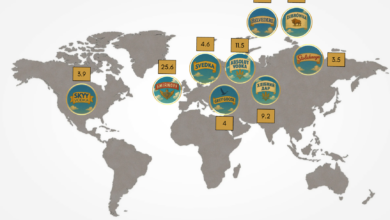41 Incredible Money Saving Challenges To Grow Wealth

THIS POST MAY CONTAIN AFFILIATE LINKS. PLEASE SEE MY DISCLOSURES FOR MORE INFORMATION
THIS POST WAS ORIGINALLY PUBLISHED ON www.moneysmartguides.com/
Do you want to save money but find that actually doing it is boring?
Wish there was a way that excited you to save so you can reach your goals?
The good news is there is a way.
It is called a savings challenge.
These are games you play to make saving money for your financial goals fun and exciting.
You can plan alone or with your family.
You can even play with friends to see who can save the most money.
In this post, I share with you 41 different money saving challenges for you to play.
You don’t have to play all of them, just pick the ones that interest you to the most and get started.
By the end of the year, you will have enjoyed saving money and will be excited to see just how much you actually saved.
And in many cases, you can save $1,000 or more using these ideas!
What Are Money Saving Challenges
A money saving challenge is a fun way to help you save money for a vacation, a new house, or anything else you want to buy.
By making it interesting to save money, you are more likely to follow through on it and reach your goal.
I’m certain you will find a challenge I list that you can get behind and be excited to complete.
Why Do A Money Savings Challenge
Saving money isn’t glamorous.
For many people, it’s not even something they think about.
As a result, it gets pushed off to some other time.
Sadly that other time never happens.
But what does happen is they lose their job, the roof leaks, or the oven breaks.
Now they need money and don’t have any savings.
By completing money saving challenges, you make it fun and exciting to put money away.
And by being fun, it makes it easier to change your habits.
If you were to try cutting out buying coffee, you might succeed for a few days, but eventually will revert back to your old habits.
By having savings goals tied to saving money, you increase the likelihood of sticking with it long term.
Then when you do need it for an emergency or another financial goal you want to achieve, you have the money.
In other words, saving money relieves some stress you might experience when you need money for something but don’t have anything saved.
Because of this, I encourage you to take part in some of the ideas I list so you can improve your financial situation and have money for the things you want in life.
41 Money Saving Challenges To Try

#1. 52 Week Money Saving Challenge
This is the classic challenge that many savers start off
The reason is because it is so simple to follow.
It works by having you save the amount that equals the week of the year we are in.
For example, there are 52 weeks in a year, so during the first week of the year, you would save $1.
During the second week, you would save $2, and so on.
By the last week of the year, week 52, you would save $52.
In total, if you save the recommended amount each week, you will end up with $1,378 saved.
The advantage of this game is that it is easy to follow along.
The drawback is it can get tough towards the end of the year to match the savings goal.
For example, during December are weeks 49 through 52, which means you need to save a total of $202 for the month.
For some readers this isn’t an issue.
But if money is tight, it can be.
#2. Reverse 52 Week Saving Challenge
This challenge is the one I just described, only in reverse.
Instead of saving $1 during the first week, you save $52.
Then in week 2 you save $51.
The amount you end up saving is the same, $1,378.
The main draw to this this version is that it motivates some people more.
For example, at the end of January, when the excitement of building your savings starts to wear off, you will have saved $202.
This could motivate you to push through to the next month.
If you do, by the end of February, you have $388 saved.
If you did the original version, you would have $36 saved by the end of February.
The bottom line is you pick which one fits your life best.
#3. Double 52 Week Savings Challenge
This is another variation on the original game.
Instead of saving $1 in week one and $2 in week two, you double the amounts.
Save $2 in week one and $4 in week two.
At the end of the year, you have $2,756 saved.
This is great for those looking to save a lot of money during the year, but it is not recommended for people on a tight budget.
#4. Random 52 Week Savings Challenge
This game is a more fun version in my opinion.
Instead of being tied to a specific amount based on the week, this one has you save a random amount each week.
It works by having you write out the saving amounts of $1 through $52.
Then you pick a random amount, save it, and cross it off.
The following week you pick another amount, save it, and cross it off.
The end result is again the same, but it allows you to play along a little more, which can help with motivating some people.
#5. Twice A Month Challenge
If saving money every week sounds like too much work for you, you can do the twice a month challenge.
Here you will save something two times a month.
You can pick the days, but most people choose the 1st and the 15th or the 15th and 30th.
And I do recommend you keep the same two days every month.
This will allow you to set up a reminder so you actually save money every month and don’t miss out.
As for the amount you save, it is completely up to you.
You can choose the same amount each time or you can save different amounts each time.
It is completely up to you.
#6. Bi-Monthly Savings Challenge

If you get paid every two weeks, this game might work best for you.
On the day you get paid, you save money.
Again, you can set up the amount you want to save.
If you plan on doing this challenge and have a savings goal for the year in mind, take that number and divide by 26, which is the number of paychecks you get.
This will be the amount you need to save every time you are paid.
For example, if your goal is to save $1,500 for the year, you need to save between $57 and $58 each time you are paid.
#7. Money Challenge For Tight Budgets
If you are on a tight budget, you don’t have to give up on these money saving challenges.
You just have to modify them.
For example, if you want to do the 52 week challenge but are concerned it is too much, cut the amounts in half.
Save $0.50 the first week, then $1 the second week and so on.
Of course you could also look at other games too.
Many of the ones I list below are perfect for people on a tight income because you save less money each week.
And don’t think you are stuck saving less.
Towards the end of the post, you will find other challenges you can play in addition to this one, which will allow you to save more money.
#8. 365 Day Money Challenge
If you are really determined to save and you do best by doing something every day to create a habit, the 365 day money challenge is for you.
With this one, you will save something every day of the year.
The catch is to make this amount something you can afford to save.
What I mean by this is there are 30 days most months.
If you try to save $10 a day, this means you will save $300 a month.
If you are living paycheck to paycheck, saving this amount of money might not be possible.
Ideally, you will look over your budget and see what a good amount is for you to save.
But don’t limit yourself by saving a save amount
If you see you can easily save $3 a day, make it a true challenge and try for $5.
This will force you to look over your spending and figure out ways to cut back.
When you are successful at this, you will get greater satisfaction for reaching your goal.
#9. Monthly Savings Challenges
Maybe saving money monthly is your game.
If this is the case, set it up so you can save as much as possible for the year.
You could take a cue from the 52 week challenge and total up the monthly saving amounts and save this each month.
For example, for January you would save $10 and in February you would save $26.
You could do the reverse of this as well, saving $202 for December in January and $186 for November in February.
Or you could save a set amount each month or even make it random too.
#10. Six Month Challenge
The six month challenge is great for people who have a short time frame to save.
Maybe you are trying to save for Christmas gifts and it is June or it’s January and you want to save for a vacation in the summer.
This game is for you.
Start off by figuring out how much you want to save.
Then divide that either by 6 if you want to save once a month or by 24 if you want to save weekly.
Here is how this looks.
Let’s say you want $1,000 for your next vacation.
If you save monthly, it comes to $166.67 a month. If you save weekly, it comes to $41.67 a week.
#11. 1% Challenge
The 1% challenge is another great option for those on a low income, or those just trying to get their finances in order.
To play this game, take 1% of your gross weekly paycheck and save that amount.
Note that I suggest you take the gross amount, which is the amount before taxes and other deductions are taken out.
The reason I suggest this is because it is a way to force you to save a little more every time you are paid.
You could choose to save 1% of your net income, but I encourage you to first try saving from your gross.
Another twist on this one is if your retirement savings are behind, simply increase your 401k contributions by 1% for the year.
Then increase it another 1% the following year.
Over time, this 1% increase will add up to thousands of dollars more.
#12. Increasing 1% Challenge

This is a fun variation of the challenge above.
You again will pick to save 1% of your paycheck, either gross income or net income.
But when you are paid next, you increase the amount you save by 1%.
For example, let’s say you choose to save 1% of your gross paycheck, which is $1,000.
You take $10 and put that into savings.
The next time you are paid, you now save 2% of your income, or $20.
If you are paid twice a month, you will be saving 26% of your income by year end.
#13. $1,000 Savings Chart
This game requires a little work to get started, but offers a nice payoff.
The goal is to have $1,000 saved after a specific amount of time.
You need to decide how long the game is played.
Let’s say you want to have $1,000 after 90 days.
You then create a chart with 90 spaces and put in a random amount next to each space.
These random amounts should total $1,000.
Then randomly pick a space each day, cross it off, and save that amount of money.
Repeat the next day and so on.
#14. $1 A Day Challenge
Here is another fun game for people with tight budgets.
Challenge yourself to save $1 a day.
Over the course of the year you will end up with $365 in savings, which is a good start for your emergency fund.
If you find that saving $1 a day is easy, you can always increase the difficulty by trying to save $2 a day as well.
#15. $5 Challenge
Instead of playing with percentages or doing any math at all, you could choose to play the $5 bill challenge.
This one has you save a $5 every time you get one.
The only catch here is you have to pay with cash on a regular basis.
If you are strictly a credit card or debit card person, you can still play it, but you won’t be saving much since you won’t have many opportunities to stash a $5 bill.
#16. $1 Challenge
Same idea as the one above, but only with a $1 bill.
I’ve played this one in the past and it is interesting.
I started out putting the dollar bills in an envelope, but in a few months, the envelope was stuffed.
I moved the cash to a shoe box and watched the pile grow.
At the end of the year, I was excited to count my money.
The let down was the big pile I had came to $178.
I’m not complaining that I saved the money, just that I was expecting more based on what appeared to be a large pile of cash.
#17. Ending In 5 Challenge
If you like the idea of the two options above but don’t pay in cash, here is an alternative for you.
Make it a habit to check your bank balance on a weekly basis.
Every time your balance ends in a 5, you transfer $5 to savings.
For example, if you have $435 in your account, you save $5.
If you have $432 you don’t do anything.
This will allow you to save money when you don’t pay in cash.
#18. Rounding Challenges
Here is a twist on the above.
When your bank balance ends in 1 through 4 or 6 through 9, you round the amount to get to a 5 or a 0.
Here is how it works.
Let’s say you have $432 in your bank account. You round down to $430 and move $2 to savings.
If you have $439 in your account, you can either round down to $435 and save $4 or round down $9 to $430.
The choice is yours and you don’t have to stick to one or the other.
To make it simple, you could choose to just round everything down to a zero or up to a zero as well.
#19. Cash Only Challenge
This is a fun option if you usually pay with plastic.
Make the switch for a month to only pay with cash.
What most people don’t realize is there is an emotional connection with money.
What I mean by this is when you have $10 in your wallet and you go to spend it, there is a moment where you think twice, simply because you see less money in your wallet.
With a credit card, you don’t experience this as there is no emotional connection with it.
The result is you will think more about spending cash and will end up spending less money.
Added to this, it is a hassle to go to the ATM every time you need cash.
You may want something, but the idea of having to go to the ATM to get cash first might be enough of a chore to get you to reconsider.
#20. Quarter A Day Challenge
For this one, you will save 1 quarter on the first day of the month, then 2 quarters on the second day, and 3 quarters on the third day.
On the 30th day of the month, you will save 30 quarters.

At the end of the month, you will have saved $116.25.
The next month you start all over again.
At the end of the year, you saved $1,426.25!
#21. Dime A Day Challenge
Same idea as above, only using dimes instead.

By the end of the year, you have $570.70 in savings.
#22. Nickel A Day Challenge
Following on the footsteps of the above is the nickel a day challenge.
Save one nickel on day one, two nickels on day two, etc.
At the beginning of the next month, you start all over again.

At the end of the year, you have $294 saved.
#23. Penny A Day Challenge
Penny a day challenges are like the quarter, dime, and nickel challenges except that you don’t restart at the beginning of each month.
You keep saving another penny based on the day, so at the end of the year, on day 365, you are saving 365 pennies.
This sounds like a lot, but only comes to $3.65 for the day.
As a result, you end the year with $667.95 in savings.
#24. Age Saving Challenge
To play this game, take your age and try to save this amount every week.
So if you are 35 years old, you will save $35 a week, which comes to $1,820 for the year.
The older you are, the more money you will save.
If saving this amount is too much for you, then dial it back and save your age every two weeks or once a month.
#25. Random Number Challenges
This is another one that involves you more in the game.
You take 31 numbers, from 1 up to 50. Then you randomly write each down on a small piece of paper and fold it in half so you can’t see it.
Put the folded up papers in a basket or a hat.
Then on the first day, pick a number and save that amount.
Put the paper to the side and the next day, pick another number and save that amount.
At the end of the month, put all the numbers back and restart.
This is the most fun game on the list.
But a word of caution, you might want to start with smaller numbers.
For example, you can still use numbers between 1 and 50, but write a handful that are 4 and 6, etc.
The reason for this is you could get into the predicament where you pull out the number 50, 45, 38, and 40 in consecutive days.
In four short days you saved $173 and aren’t even through the first week!
Or if money is tight, you can cap the highest amount at $20 and include less than whole dollars to save to make up the difference.
For example, you might save $1.25 or $3.65.
#26. Windfall Challenge
This game can lead to some serious savings if you are dedicated to it.
Whenever you come into money you weren’t expecting, like money for your birthday, a tax refund, other gifts, etc. you need to save it or a portion of it.
For small amounts like birthday money or small lottery winnings, save the entire amount.
For larger windfalls, like tax refunds, save 50% of it.
I know that saving that much sounds like a lot, but you can do it.
If your tax refund is $3,000 you save $1,500 and get to spend the other $1,500.
Ideally you would save more than 50% but this is a good starting point.
If you commit to this challenge and one of the others I list, there is no reason you can’t end up with $3,000 or more of savings in just one year!
#27. No Spend Challenges
Here is another fun game to try.
Pick a spending category that you want to cut back on and try to go a set amount of time without spending money.
Most people choose either 7 days or 30 days for this challenge to last.
What categories can you pick from?
The easiest are eating out at restaurants, going to the bars, spending money on entertainment, coffee, Uber/Lyft, etc.
Basically and discretionary spending category that you can still live if you do without.
For example, you wouldn’t do this with your mortgage/rent or electric bill.
#28. No Spend Weekend
If you find yourself overspending on the weekends, do a no spend weekend challenge.
Pick a weekend and choose to not spend any money, no matter what.
No fun nights out, no groceries, no gas, nothing.
While the goal here isn’t to have you give up spending completely on the weekends going forward, it is to open your mind to the idea of spending less money.
Many of us spend on the weekends because we get bored.
By finding other things to do that are free, you can start doing these things on a regular basis, saving yourself money in the long run.
#29. Extra Money Challenge

Instead of saving money you have or didn’t spend, this game asks you to find new money.
Set up a goal for how much extra money you want per month.
Then figure out ways to find the extra cash.
There are many ways you can do this.
You can find things around your house you don’t want and sell.
You could pick up a side hustle completing surveys.
You could recycle scrap metal or start an Etsy shop.
The choices are endless.
I personally love this one as it gets you to think outside the box for ways to bring in additional income.
And in some cases, you might stumble upon an idea you love to do and can make a decent amount of money from if you put in the effort.
The only word of caution is to start off small.
Many people will be tempted to set a goal of $500 a month.
I recommend starting out with $50 as this will be challenging for most people.
As you get good at this, increase the amount.
#30. Spare Change Challenge
To make this game easier, I recommend you use Qapital.
It works like this.
You pick a savings goal, say emergency savings, vacation, or whatever you want.
Then you link your bank account to Qapital.
- Read now: Click here to learn more about Qapital
When you spend money, Qapital will round up your purchase to the nearest dollar and transfer that amount to a savings account for you.
So if you spend $10.84, Qapital will round that up to $11 and transfer $0.16 to a savings account for you.
You can also choose to save a set amount, like $1 a month on top of this as well.
They even offer some of the saving challenges I list here as options to boost your savings.
#31. Vices Savings Challenge
We all have our vices.
Whether it is buying Starbucks, smoking cigarettes, staying up late, etc.
This type of challenge is a way to “punish” you when you do these things.
First, pick your vice, then pick an amount you will save when you give in to your vice.
For example, let’s say my vice is drinking soda. Every time I drink a soda, I owe myself $5.
If I drink 8 sodas in a month, I will have $40 in my savings account at month end.
The trick here is you have to be accountable to yourself.
You can easily drink the soda and not punish yourself my making the transfer.
Other times you might be busy and tell yourself you will transfer the money later in the day but forget.
There are ways around this, from always transferring the money right away, to keeping a note in your smartphone when you give in to your vice and when you transfer the money.
But at the end of the day, it is all about being accountable.
#32. Vices Challenge Alternative
An alternative to this idea is to save the money when you cut the vice out.
So if you drink Starbucks and skip it one day, you take the money you would have spent and move it into savings.
Again, you have to be accountable here and most times moving the money right away is a good solution.
#33. Weather Challenge
This is a fun option and it up to you for how you want to play it.
You could pick a day of the week, say Friday and whatever the high temperature is in your area that day, you save that amount of money.
Or you could decide to save $5 every time it rains.
It doesn’t have to stop with the weather either.
If weather doesn’t interest you, pick something that does.
For example, let’s say you enjoy football.
Whatever your team score is at the end of the game, you save that amount.
If you enjoy trying new recipes, save $5 every time you try something new.
The possibilities for ways to save are endless.
#34. Save The Savings
This is fun game I started doing when money was super tight after I bought my first house.
One day after grocery shopping, I noticed at the end of the receipt it told me how much I saved in large font.
I guess they wanted me to focus on this number instead of what I actually spent so I would have a good feeling about the store.
While I could have done nothing about it, I decided to actually save this money when I got home.
After I put my groceries away, I sat down and made the transfer.
Then I made it a point to do this every time I went grocery shopping.
The amount I saved each time varied based on what I needed, what was on sale, the coupons I had, etc.
I averaged about $15 a week, which comes to $780 a year.
After a few months however, I expanded this idea to other shopping trips as well.
When I bought anything on sale, I made it a point to transfer the savings so I actually saved it.
Fast forward to today and I still play this game.
It’s a lot of fun and an easy way to set money aside.
#35. Pantry Challenge
Most people do the pantry challenge in January since saving money is a resolution for many.
However, you can do it any month you want.
The idea is to limit or even eliminate grocery spending for a month.
Instead, you go through your pantry and make meals based on what you have.
Since we all have the food that gets stuffed in the back of the pantry, or buried in the freezer, this is a great way to use the food and not waste money.
The interesting part for many comes towards the end of the month.
You get to a point where you are making your own potluck meals because you have random food items to use.
#36. Pause Game
We all make impulse buys now and then.
The pause game is a way to help you overcome this.
Before you buy something you want and weren’t planning on buying, pause for a minute.
Ask yourself why you want it.
How will it improve your like? How will you use? How often will you use it?
The more questions you can ask yourself, the better.
This is because you will discover if the item truly is an impulse buy or if it will really benefit you and you will use it.
#37. Would You Rather Game
A twist on the above is the would you rather game.
Again, before buying something you want, ask yourself a simple question.
Would you rather have the item or the cash?
Asking this basic question will really get to the root of your desire.
If you find you would rather have the cash, make sure you transfer the money you saved by not wasting the money into a savings account.
#38. 30 Day Rule
An alternative to the last two ideas is the 30 day rule.
Before you buy something you want, you have to wait 30 days.
This helps you avoid impulse buys.
But by waiting 30 days, it helps you in other ways as well.
Here is how this works.
For the first 10 days, simply forget about the item completely. If you are successful at that this, then it truly was an impulse buy.
If you are still thinking about it after 10 days, spend the next 10 days doing research.
Look into the benefits and drawbacks of the item and see if there are any alternatives that are better or cost less money.
After this time, if you still find you want the item, spend the next 10 days looking for ways to reduce the cost.
Can you wait until it is on sale? Can you find a used version on Facebook Marketplace?
Maybe you can find some coupon codes to reduce the price.
By following this strategy, you can limit impulse buys and save money if you do move forward with the purchase.
#39. Dollar Store Challenge
The next time you need to go shopping, make your list and visit the dollar store first.
Then see how many things you can buy there instead of at other stores.
The first time I did this, I was amazed at how much I saved.
Greeting cards at the dollar store are usually $0.50 or $1.00 which is a huge savings.
I found personal care items like body wash and shampoo.
I even found a tube of caulk that I needed.
In just one trip, I spent $5.50.
If I were to buy these things as I normally would, it would have cost me close to $25!
When I got home, I make sure to transfer the money I saved to my savings account too!
#40. Generic Brands Challenge
Related to the above point is to try to buy generic brands as much as possible.
Store brands get a bad rap, but they have come a long way.
Many of the items we buy are now store brand items.
The taste and quality are comparable to brand names and the savings is huge.
I challenge you to buy private label items and feed your family without telling them. Chances are they won’t even notice a difference.
#41. Shopping List Challenge
We all buy things we never intended to buy.
Whether it is tempted with the donuts at the grocery store or some random item at Walmart, something catches our eye and we buy it.
The challenge here is to make a list before you go out shopping.
Write down the things you need and stick to the list.
If the item you see and want isn’t on your list, then you cannot buy it.
This teaches us self control and to learn how to not give into our impulses.
Trust me, it is hard at first, but gets easier as you do it more.
But you will always have your weak moments where you have to fight the urge, no matter how long you have practiced self control.
Where To Put The Money You Save

Any money you save needs to be put into a savings account.
You can’t leave the money you save in your checking account because you will be tempted to spend it.
By moving it out of your checking account, you won’t see it as often and as a result, won’t justify reasons to spend it.
For example, when I was playing one of the games I listed, I didn’t move the money into my savings account.
I was just happy to be saving money.
But after a few months I realized I wasn’t getting ahead financially.
All the work I was doing to save money was wasted because I was just finding other things to spend my money on.
Once I proactively moved the money I saved into a dedicated account, I finally started to get ahead.
So make it a point to put your money into a savings account.
I personally use and recommend CIT Bank.
This is an online bank that pays a lot more interest than my local bank, which means my money grows even faster.
My process to save was to put all my money into one account, which was my emergency fund.
Once I got the balance of this up to $5,000 I opened another savings account.
I split the money saved between these 2 accounts.
One was for emergencies and the other was for long term savings.
You can do it however you want.
I found though having a savings account for each savings goal helped motivate me as I saw the balance for each goal.
Final Thoughts
There are 41 money saving challenges for you to try.
Pick the ones you find most interesting to you and give them a go.
By making a game out of saving money, you will be motivated to play longer and as you see your bank balance increase in size, you will be even more motivated.
Just make sure you follow my tips to create a dedicated savings account and to move any money into savings.
And don’t fall for the trap that thinking saving even a little bit of money isn’t worth it.
Thanks to compounding, anything you save will grow into larger amounts if you give it enough time.
Of course, if you are in debt, you can use the savings to pay off your balances and become debt free as well.




